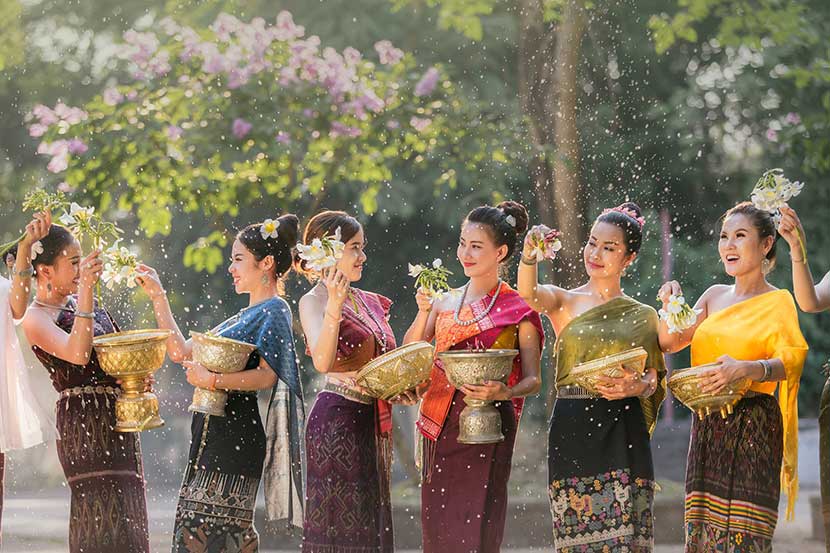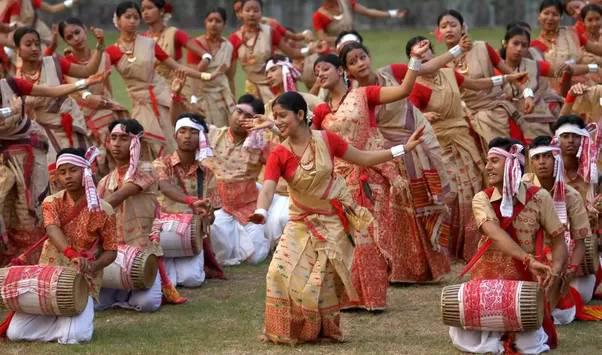Friday, April 12, 2024

This week, Asia lights up with a series of vibrant festivals, each one celebrating the rich tapestry of traditions, history, and community spirit that define the region. From Thailand’s water-splashed streets during Songkran to the rhythmic dances of Bihu in Assam, these festivals not only mark the lunar new year and harvest but also strengthen the cultural connections among communities.
Songkran: Thailand’s Water Festival
Songkran, Thailand’s most famous festival, heralds the Thai New Year with a splash. Traditionally held from April 13th to 15th, Songkran is synonymous with massive water fights, a symbol of washing away the past year’s misfortunes. Originally, the water was used to cleanse images of the Buddha, symbolizing purification and renewal. Today, it transforms into spirited public celebrations that see locals and tourists alike dousing each other with water through water guns, hoses, and buckets. The festival also includes parades featuring Buddha statues, where water is gently poured over the figures as a sign of respect and for good fortune.

Lao New Year: Pi Mai Lao in Luang Prabang
Pi Mai Lao, or Lao New Year, is celebrated in mid-April, with the historic city of Luang Prabang hosting some of the most picturesque festivities. The celebration is marked by parades, beauty contests, music, and dances, reflecting the rich cultural heritage of Laos. Like Songkran in Thailand, water plays a crucial role in the festivities, used for washing homes, Buddha statues, and gently pouring on others as a blessing for good luck. The festival is deeply spiritual, focusing on renewal and purification.

Bihu: Assam’s Celebration of New Beginnings
In the northeastern state of Assam, India, Bihu is a set of three important festivals, primarily signifying the Assamese New Year and the spring harvest. The most prominent, Rongali Bihu, occurs in mid-April, marking the beginning of the planting season. The festivities are filled with folk dances and songs, traditional games, and community feasts. Bihu dancers, dressed in vibrant Assamese clothing, perform to the beat of drums like the dhol and pepa, a horn made from buffalo horn. Bihu is not just a celebration but a lifeline of the Assamese culture, showcasing their heritage and agricultural practices.

Pohela Boishakh: Bangladeshi New Year
Pohela Boishakh is the Bangladeshi New Year celebrated on April 14th each year, a major festive event for the Bengali populace in Bangladesh and around the world. The day is marked with parades, fairs, and cultural dances, deeply rooted in rural traditions and customs. Festivities begin at dawn with the singing of Rabindranath Tagore’s song “Esho, he Boishakh,” calling everyone to embrace the new year. Streets are adorned with colorful alpanas (rangolis), and people enjoy traditional foods like panta bhat (water-soaked rice), hilsa fish, and sweets made from rice and palm syrup.
Baisakhi: Punjab’s Harvest Festival
Baisakhi, or Vaisakhi, celebrated on April 14th each year, is not only a harvest festival but also holds religious significance for Sikhs as it marks the foundation of the Khalsa Panth. Across Punjab, gurdwaras are decorated, and parades known as Nagar Kirtan are led by the Panj Piaras (Five Beloved Ones). Traditional performances, music, dancing, and the sharing of meals, or langars, are widespread. Farmers thank the divine for the bountiful harvest and pray for future prosperity. Baisakhi fairs, which include acrobatics, wrestling bouts, and folk music, provide entertainment and a vibrant atmosphere.
Nabanna: West Bengal’s Harvest Celebration
In West Bengal, Nabanna is the festival celebrating the new harvest, typically occurring around October or November. However, the spirit of Nabanna is akin to the April harvest festivals in its celebration of new crops. Traditional folk dances, songs, and the distribution of new rice, cooked into various dishes, mark this festival. Nabanna is a time of joy and prosperity, reflecting West Bengal’s agrarian roots and the significance of rice in their culture.
Tags: asian countries, India, South East Asia, Thailand
Monday, April 29, 2024
Monday, April 29, 2024
Monday, April 29, 2024